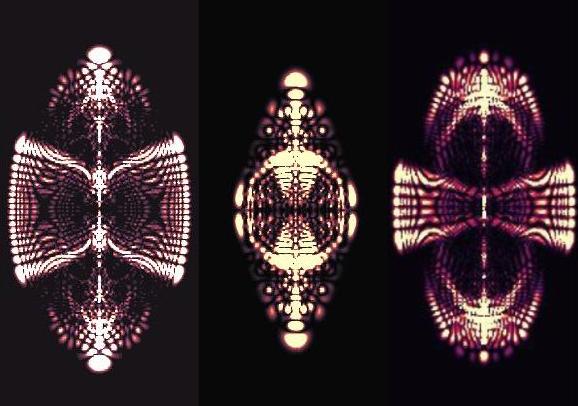(1)Rydberg molecules in external fields: Semiclassical analysis , Matzkin A. and Monteiro T S., Phys.Rev Lett 87 143002 (2001)
(2)Closed Orbit theory for molecules in fields ,Matzkin A., Dando P.A., Monteiro,T. S. Phys Rev A 66 013410 (2002).
(3)Contribution of forbidden orbits in the photoabsorption spectra of atoms and molecules in a magnetic field, Matzkin A., Dando P.A., Monteiro,T. S., Phys Rev A 67 , 023402 (2003).
Highly excited ('Rydberg') hydrogen atoms in strong magnetic fields became, from around 1987, a paradigm of a real system where the 'fingerprints' of quantum chaos are much in evidence. The classical trajectories of the atomic electron make a transition from regularity to chaos as the field strength increases. The importance of this system was due to its special scaling properties: by keeping the product [energy times magnetic field^(-2/3)] constant one can generate large numbers of quantum states all corresponding to the same classical dynamics (but different effective value of Planck's constant!). Hence it lends itself to detailed analysis of the properties of the experimental and calculated spectra. Initially, corresponding Rydberg molecules seemed to be more difficult. However, we found a way of obtaining scaled spectra and thus were able to test our new theory, which describes a simple molecular system (see Refs(1-3)).
| In a classic paper in 1970, Ugo Fano analysed the field-free photoabsorption of H2 molecules from the ground state (J=0, l=0) to a highly excited 'Rydberg' state of the electron (J=1, l=1, high n). He showed that as the electron moves far from the H2+ core, the latter is left in a superposition of N=0 and N=2 rotational states. Since energy is conserved, the N=0 electron has high energy, while the N=2 electron has rather less energy. Hence, in a magnetic field, N=0 can correspond to the electronic motion in the nearly chaotic (scaled energy =-0.2) regime, while N=2 corresponds to a regular (sc.energy =-0.8) regime, for example. Our theoretical approach involved combining Closed Orbit theory from quantum chaology with the Multi-channel Quantum Defect Theory of Fano, to give a sum over paths formula appropriate for a molecule. The formula was compared with a scaled R-matrix type calculation. As a result we were able to identify contributions from a novel type of inelastic-diffractive path, in other words a semiclassical path which switches between the N=0 and N=2 components when it passes through the core region. In other words, the core and electronic states are 'entangled' with each other and the inelastic-diffractive path connects the different components of this entangled state. The figure shows 3 typical wavefunctions; the middle one in particular shows a contribution from N=2 localised on a stable island and a 'scar' type contribution from the N=0 component. Note that this physics is distinct from the usual mixed-phase-space classical dynamics. The energy level statistics are also atypical. |
 |
